Health Promotion IV: Harm Reduction Strategy - Needle Exchange Program
VerifiedAdded on 2023/06/10
|5
|1204
|180
Presentation
AI Summary
This presentation evaluates the needle exchange program (NEP) as a harm reduction strategy for substance abuse among teenagers. It highlights the negative social, financial, and health consequences of substance abuse in youth. The presentation details the rationale for choosing NEP, emphasizing its focus on minimizing risks associated with diseases like HIV/AIDS and hepatitis. It discusses the roles of Licensed Practical Nurses (LPNs), registered nurses, and doctors in implementing and promoting the program, including providing advice, managing withdrawal symptoms, and educating patients. The presentation also addresses ethical considerations such as the dilemma faced by clients fearing apprehension and the potential for increased substance abuse. Cultural considerations are examined, noting the program's focus on individual health while potentially neglecting negative community impacts. The presentation concludes by acknowledging the potential adverse effects of NEP, such as increased crime and decreased property values in host communities.
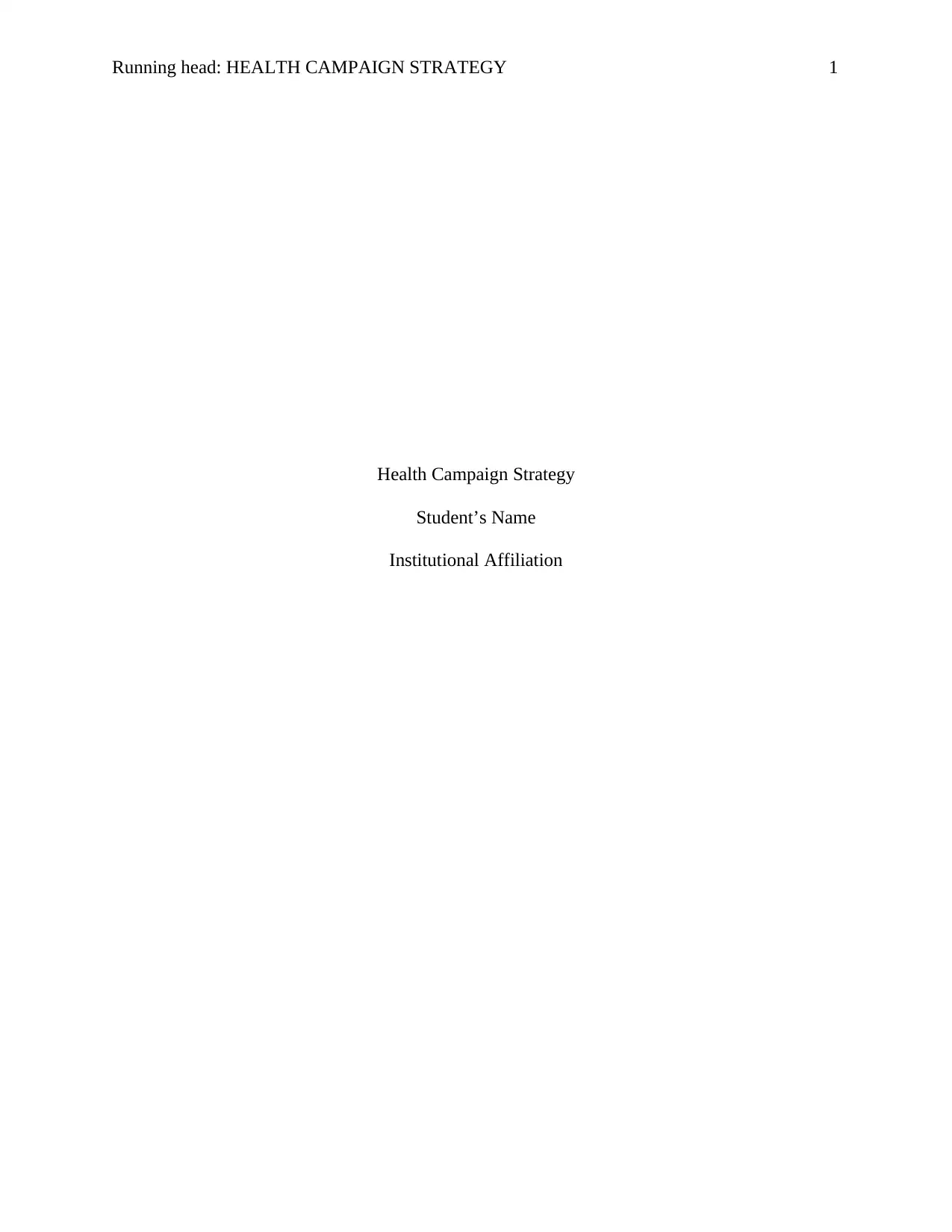
Running head: HEALTH CAMPAIGN STRATEGY 1
Health Campaign Strategy
Student’s Name
Institutional Affiliation
Health Campaign Strategy
Student’s Name
Institutional Affiliation
Paraphrase This Document
Need a fresh take? Get an instant paraphrase of this document with our AI Paraphraser
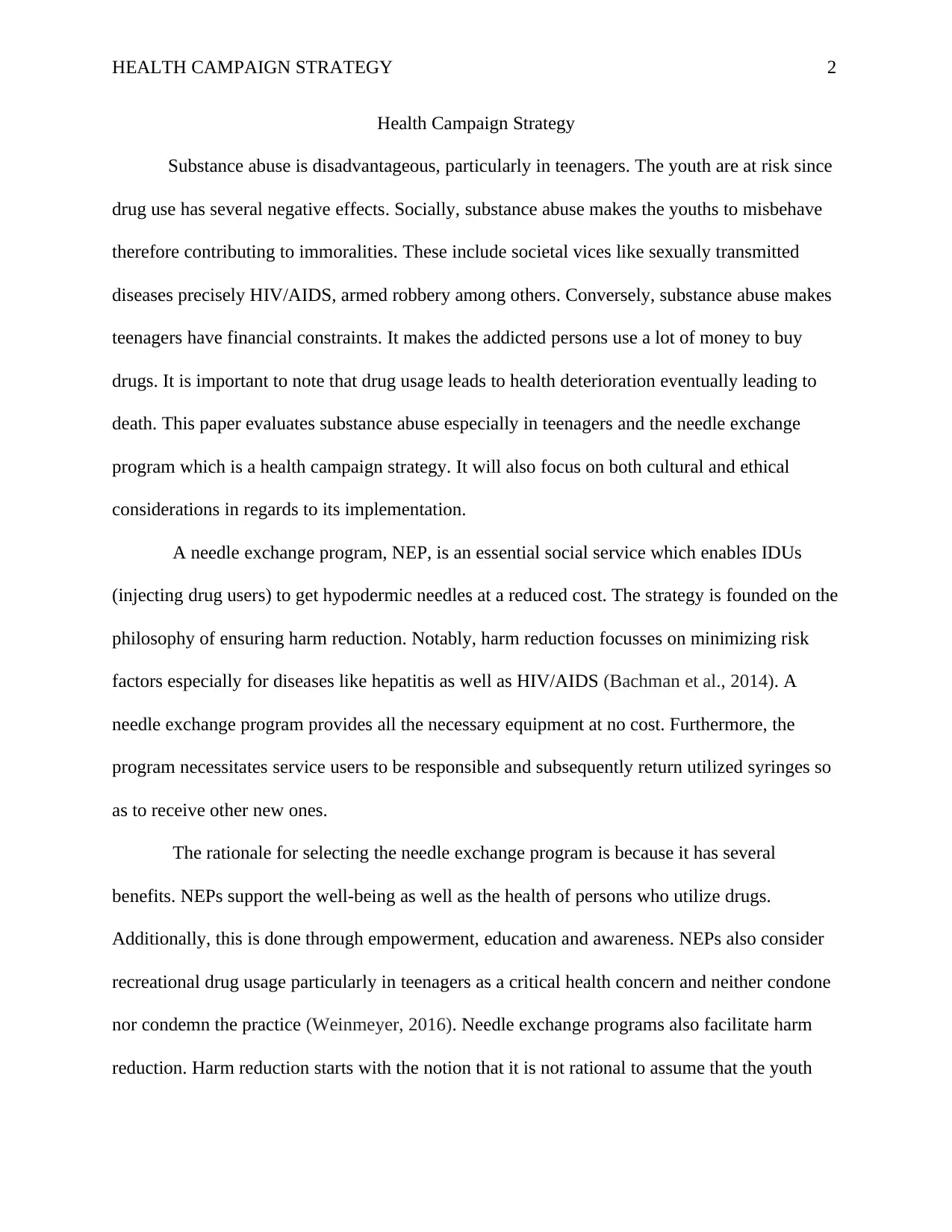
HEALTH CAMPAIGN STRATEGY 2
Health Campaign Strategy
Substance abuse is disadvantageous, particularly in teenagers. The youth are at risk since
drug use has several negative effects. Socially, substance abuse makes the youths to misbehave
therefore contributing to immoralities. These include societal vices like sexually transmitted
diseases precisely HIV/AIDS, armed robbery among others. Conversely, substance abuse makes
teenagers have financial constraints. It makes the addicted persons use a lot of money to buy
drugs. It is important to note that drug usage leads to health deterioration eventually leading to
death. This paper evaluates substance abuse especially in teenagers and the needle exchange
program which is a health campaign strategy. It will also focus on both cultural and ethical
considerations in regards to its implementation.
A needle exchange program, NEP, is an essential social service which enables IDUs
(injecting drug users) to get hypodermic needles at a reduced cost. The strategy is founded on the
philosophy of ensuring harm reduction. Notably, harm reduction focusses on minimizing risk
factors especially for diseases like hepatitis as well as HIV/AIDS (Bachman et al., 2014). A
needle exchange program provides all the necessary equipment at no cost. Furthermore, the
program necessitates service users to be responsible and subsequently return utilized syringes so
as to receive other new ones.
The rationale for selecting the needle exchange program is because it has several
benefits. NEPs support the well-being as well as the health of persons who utilize drugs.
Additionally, this is done through empowerment, education and awareness. NEPs also consider
recreational drug usage particularly in teenagers as a critical health concern and neither condone
nor condemn the practice (Weinmeyer, 2016). Needle exchange programs also facilitate harm
reduction. Harm reduction starts with the notion that it is not rational to assume that the youth
Health Campaign Strategy
Substance abuse is disadvantageous, particularly in teenagers. The youth are at risk since
drug use has several negative effects. Socially, substance abuse makes the youths to misbehave
therefore contributing to immoralities. These include societal vices like sexually transmitted
diseases precisely HIV/AIDS, armed robbery among others. Conversely, substance abuse makes
teenagers have financial constraints. It makes the addicted persons use a lot of money to buy
drugs. It is important to note that drug usage leads to health deterioration eventually leading to
death. This paper evaluates substance abuse especially in teenagers and the needle exchange
program which is a health campaign strategy. It will also focus on both cultural and ethical
considerations in regards to its implementation.
A needle exchange program, NEP, is an essential social service which enables IDUs
(injecting drug users) to get hypodermic needles at a reduced cost. The strategy is founded on the
philosophy of ensuring harm reduction. Notably, harm reduction focusses on minimizing risk
factors especially for diseases like hepatitis as well as HIV/AIDS (Bachman et al., 2014). A
needle exchange program provides all the necessary equipment at no cost. Furthermore, the
program necessitates service users to be responsible and subsequently return utilized syringes so
as to receive other new ones.
The rationale for selecting the needle exchange program is because it has several
benefits. NEPs support the well-being as well as the health of persons who utilize drugs.
Additionally, this is done through empowerment, education and awareness. NEPs also consider
recreational drug usage particularly in teenagers as a critical health concern and neither condone
nor condemn the practice (Weinmeyer, 2016). Needle exchange programs also facilitate harm
reduction. Harm reduction starts with the notion that it is not rational to assume that the youth
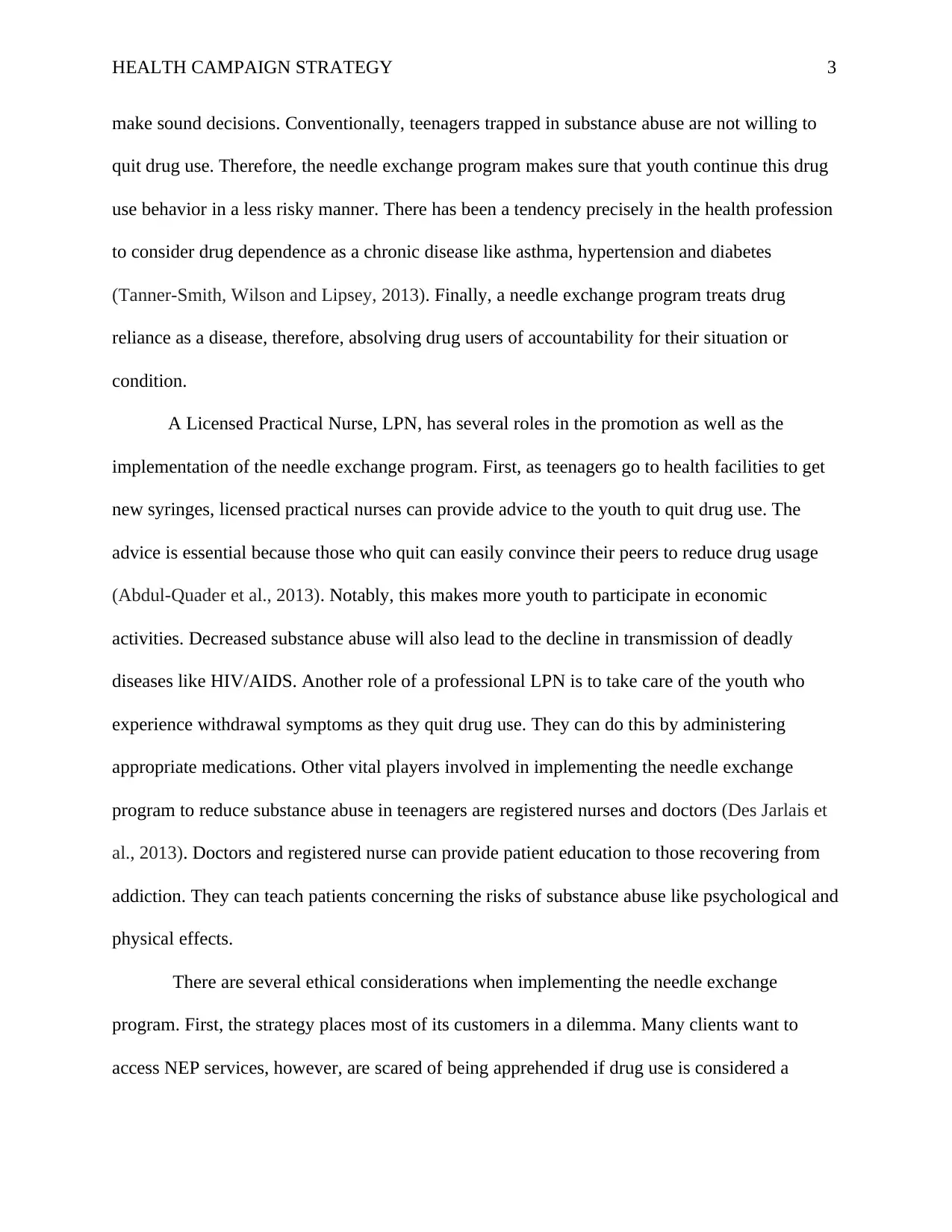
HEALTH CAMPAIGN STRATEGY 3
make sound decisions. Conventionally, teenagers trapped in substance abuse are not willing to
quit drug use. Therefore, the needle exchange program makes sure that youth continue this drug
use behavior in a less risky manner. There has been a tendency precisely in the health profession
to consider drug dependence as a chronic disease like asthma, hypertension and diabetes
(Tanner-Smith, Wilson and Lipsey, 2013). Finally, a needle exchange program treats drug
reliance as a disease, therefore, absolving drug users of accountability for their situation or
condition.
A Licensed Practical Nurse, LPN, has several roles in the promotion as well as the
implementation of the needle exchange program. First, as teenagers go to health facilities to get
new syringes, licensed practical nurses can provide advice to the youth to quit drug use. The
advice is essential because those who quit can easily convince their peers to reduce drug usage
(Abdul-Quader et al., 2013). Notably, this makes more youth to participate in economic
activities. Decreased substance abuse will also lead to the decline in transmission of deadly
diseases like HIV/AIDS. Another role of a professional LPN is to take care of the youth who
experience withdrawal symptoms as they quit drug use. They can do this by administering
appropriate medications. Other vital players involved in implementing the needle exchange
program to reduce substance abuse in teenagers are registered nurses and doctors (Des Jarlais et
al., 2013). Doctors and registered nurse can provide patient education to those recovering from
addiction. They can teach patients concerning the risks of substance abuse like psychological and
physical effects.
There are several ethical considerations when implementing the needle exchange
program. First, the strategy places most of its customers in a dilemma. Many clients want to
access NEP services, however, are scared of being apprehended if drug use is considered a
make sound decisions. Conventionally, teenagers trapped in substance abuse are not willing to
quit drug use. Therefore, the needle exchange program makes sure that youth continue this drug
use behavior in a less risky manner. There has been a tendency precisely in the health profession
to consider drug dependence as a chronic disease like asthma, hypertension and diabetes
(Tanner-Smith, Wilson and Lipsey, 2013). Finally, a needle exchange program treats drug
reliance as a disease, therefore, absolving drug users of accountability for their situation or
condition.
A Licensed Practical Nurse, LPN, has several roles in the promotion as well as the
implementation of the needle exchange program. First, as teenagers go to health facilities to get
new syringes, licensed practical nurses can provide advice to the youth to quit drug use. The
advice is essential because those who quit can easily convince their peers to reduce drug usage
(Abdul-Quader et al., 2013). Notably, this makes more youth to participate in economic
activities. Decreased substance abuse will also lead to the decline in transmission of deadly
diseases like HIV/AIDS. Another role of a professional LPN is to take care of the youth who
experience withdrawal symptoms as they quit drug use. They can do this by administering
appropriate medications. Other vital players involved in implementing the needle exchange
program to reduce substance abuse in teenagers are registered nurses and doctors (Des Jarlais et
al., 2013). Doctors and registered nurse can provide patient education to those recovering from
addiction. They can teach patients concerning the risks of substance abuse like psychological and
physical effects.
There are several ethical considerations when implementing the needle exchange
program. First, the strategy places most of its customers in a dilemma. Many clients want to
access NEP services, however, are scared of being apprehended if drug use is considered a
⊘ This is a preview!⊘
Do you want full access?
Subscribe today to unlock all pages.

Trusted by 1+ million students worldwide
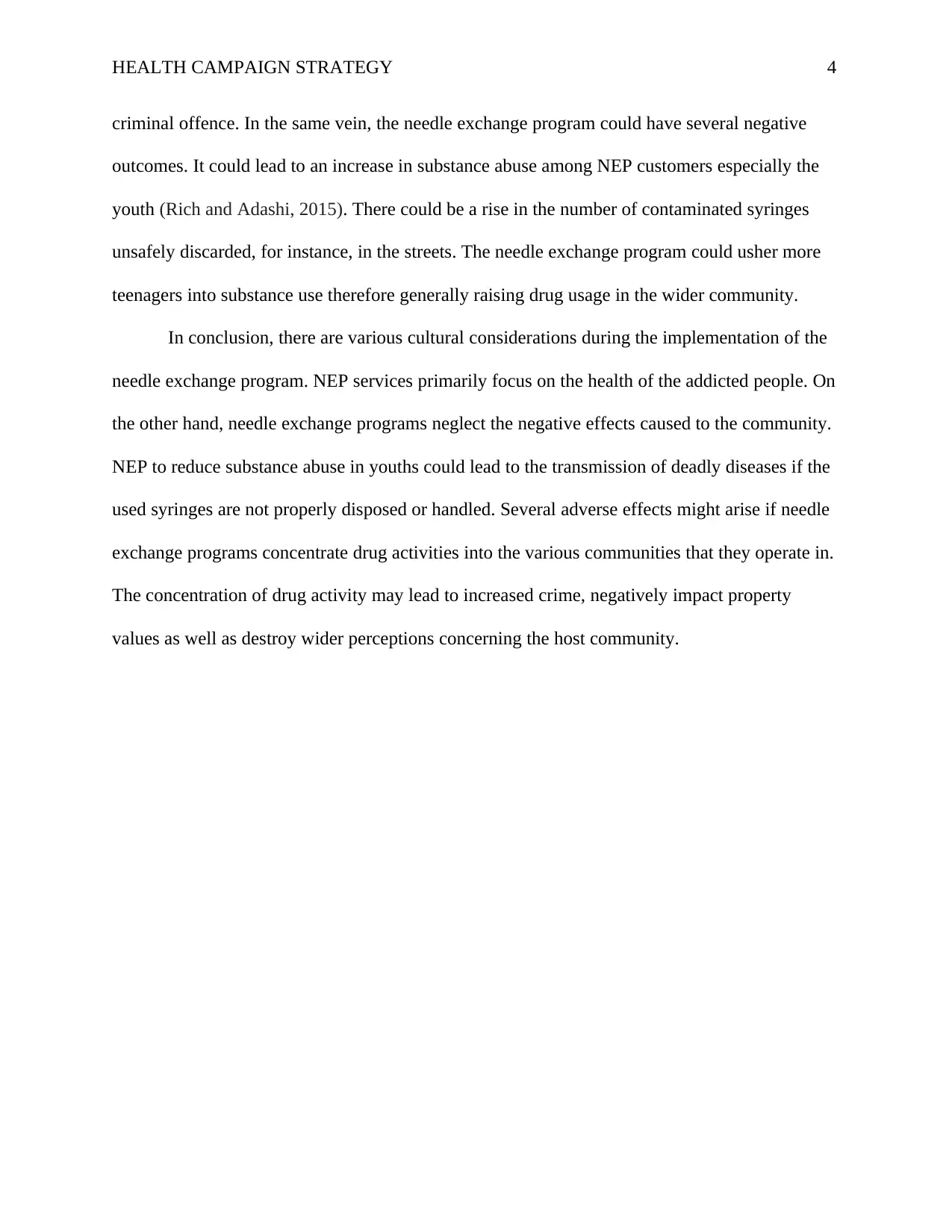
HEALTH CAMPAIGN STRATEGY 4
criminal offence. In the same vein, the needle exchange program could have several negative
outcomes. It could lead to an increase in substance abuse among NEP customers especially the
youth (Rich and Adashi, 2015). There could be a rise in the number of contaminated syringes
unsafely discarded, for instance, in the streets. The needle exchange program could usher more
teenagers into substance use therefore generally raising drug usage in the wider community.
In conclusion, there are various cultural considerations during the implementation of the
needle exchange program. NEP services primarily focus on the health of the addicted people. On
the other hand, needle exchange programs neglect the negative effects caused to the community.
NEP to reduce substance abuse in youths could lead to the transmission of deadly diseases if the
used syringes are not properly disposed or handled. Several adverse effects might arise if needle
exchange programs concentrate drug activities into the various communities that they operate in.
The concentration of drug activity may lead to increased crime, negatively impact property
values as well as destroy wider perceptions concerning the host community.
criminal offence. In the same vein, the needle exchange program could have several negative
outcomes. It could lead to an increase in substance abuse among NEP customers especially the
youth (Rich and Adashi, 2015). There could be a rise in the number of contaminated syringes
unsafely discarded, for instance, in the streets. The needle exchange program could usher more
teenagers into substance use therefore generally raising drug usage in the wider community.
In conclusion, there are various cultural considerations during the implementation of the
needle exchange program. NEP services primarily focus on the health of the addicted people. On
the other hand, needle exchange programs neglect the negative effects caused to the community.
NEP to reduce substance abuse in youths could lead to the transmission of deadly diseases if the
used syringes are not properly disposed or handled. Several adverse effects might arise if needle
exchange programs concentrate drug activities into the various communities that they operate in.
The concentration of drug activity may lead to increased crime, negatively impact property
values as well as destroy wider perceptions concerning the host community.
Paraphrase This Document
Need a fresh take? Get an instant paraphrase of this document with our AI Paraphraser
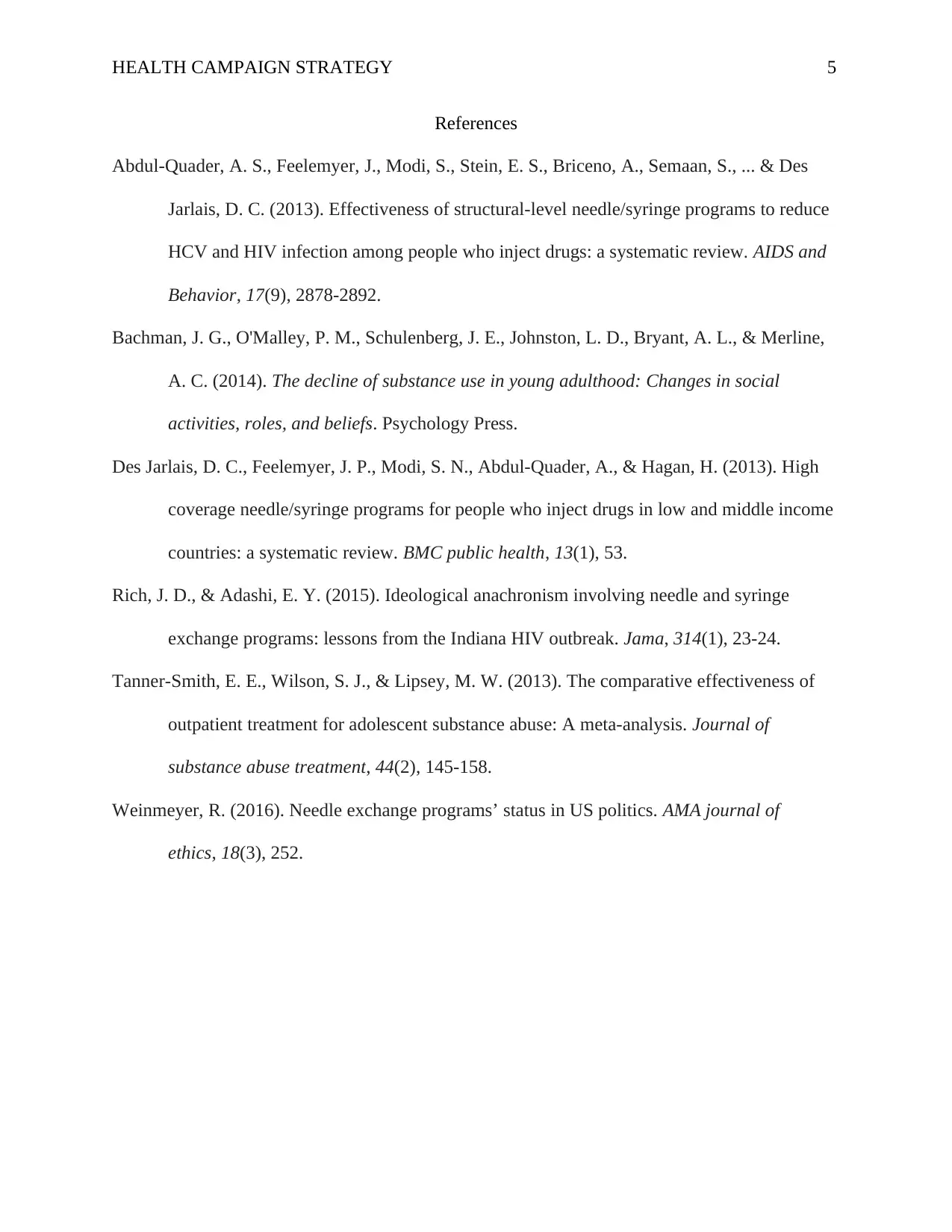
HEALTH CAMPAIGN STRATEGY 5
References
Abdul-Quader, A. S., Feelemyer, J., Modi, S., Stein, E. S., Briceno, A., Semaan, S., ... & Des
Jarlais, D. C. (2013). Effectiveness of structural-level needle/syringe programs to reduce
HCV and HIV infection among people who inject drugs: a systematic review. AIDS and
Behavior, 17(9), 2878-2892.
Bachman, J. G., O'Malley, P. M., Schulenberg, J. E., Johnston, L. D., Bryant, A. L., & Merline,
A. C. (2014). The decline of substance use in young adulthood: Changes in social
activities, roles, and beliefs. Psychology Press.
Des Jarlais, D. C., Feelemyer, J. P., Modi, S. N., Abdul-Quader, A., & Hagan, H. (2013). High
coverage needle/syringe programs for people who inject drugs in low and middle income
countries: a systematic review. BMC public health, 13(1), 53.
Rich, J. D., & Adashi, E. Y. (2015). Ideological anachronism involving needle and syringe
exchange programs: lessons from the Indiana HIV outbreak. Jama, 314(1), 23-24.
Tanner-Smith, E. E., Wilson, S. J., & Lipsey, M. W. (2013). The comparative effectiveness of
outpatient treatment for adolescent substance abuse: A meta-analysis. Journal of
substance abuse treatment, 44(2), 145-158.
Weinmeyer, R. (2016). Needle exchange programs’ status in US politics. AMA journal of
ethics, 18(3), 252.
References
Abdul-Quader, A. S., Feelemyer, J., Modi, S., Stein, E. S., Briceno, A., Semaan, S., ... & Des
Jarlais, D. C. (2013). Effectiveness of structural-level needle/syringe programs to reduce
HCV and HIV infection among people who inject drugs: a systematic review. AIDS and
Behavior, 17(9), 2878-2892.
Bachman, J. G., O'Malley, P. M., Schulenberg, J. E., Johnston, L. D., Bryant, A. L., & Merline,
A. C. (2014). The decline of substance use in young adulthood: Changes in social
activities, roles, and beliefs. Psychology Press.
Des Jarlais, D. C., Feelemyer, J. P., Modi, S. N., Abdul-Quader, A., & Hagan, H. (2013). High
coverage needle/syringe programs for people who inject drugs in low and middle income
countries: a systematic review. BMC public health, 13(1), 53.
Rich, J. D., & Adashi, E. Y. (2015). Ideological anachronism involving needle and syringe
exchange programs: lessons from the Indiana HIV outbreak. Jama, 314(1), 23-24.
Tanner-Smith, E. E., Wilson, S. J., & Lipsey, M. W. (2013). The comparative effectiveness of
outpatient treatment for adolescent substance abuse: A meta-analysis. Journal of
substance abuse treatment, 44(2), 145-158.
Weinmeyer, R. (2016). Needle exchange programs’ status in US politics. AMA journal of
ethics, 18(3), 252.
1 out of 5
Related Documents
Your All-in-One AI-Powered Toolkit for Academic Success.
+13062052269
info@desklib.com
Available 24*7 on WhatsApp / Email
![[object Object]](/_next/static/media/star-bottom.7253800d.svg)
Unlock your academic potential
Copyright © 2020–2025 A2Z Services. All Rights Reserved. Developed and managed by ZUCOL.





